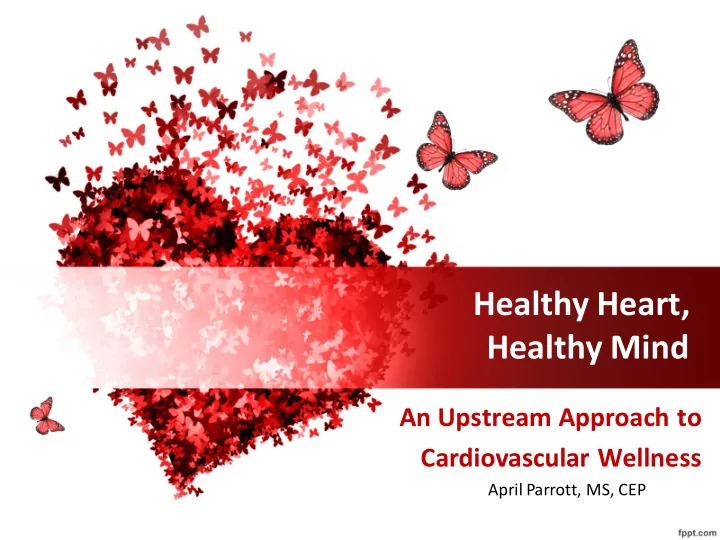

Healthy Heart, Healthy Mind An Upstream Approach to Cardiovascular Wellness April Parrott, MS, CEP
Objectives • Identify cardiovascular risk factors • Interpret health stats and values • Understand ways to modify cardiovascular risk factors • Describe what it means to ‘Know your numbers’ and how to control disease and improve quality of life • Discuss strategies for beginning and maintaining health behaviors
Top 10 Leading Causes of Death 1. Heart disease 2. Cancer 3. Accidents 4. Respiratory diseases 5. Cerebrovascular diseases 6. Alzheimer’s Disease 7. Diabetes mellitus 8. Influenza & pneumonia 9. Kidney disease 10.Suicide National Vital Statistics Reports, Vol. 67, No. 5, July 26, 2018, Pg. 6
What do you value the most in your life?
Risk Factors
Cardiovascular Risk Factors Something that increases a person's chances of developing CVD • Age • Obesity • Family history • Physical inactivity • Cholesterol • Smoking • Diabetes • Stress • Hypertension
Do you “Know Your Numbers”? 1. Answer the questions to the best of your ability 2. Leave blank what you do not know
Age
Cholesterol Total Cholesterol High Density Lipoprotein (HDL) Low Density Lipoprotein (LDL) Triglycerides (TG)
Obesity
Physical Activity ≥ 150 min/week of moderate intensity
Smoking DON’T
Stress
Risk Factor Assessment 1. Use your answers from your “Know Your Numbers” WS 2. If your value is out of range or a YES then mark the box 3. Add up the number of checked boxes and use with your last known blood pressure average to calculate your risk for CVD
SMART Goals Specific Measurable Achievable Relevant Time-Bound Clearly define Quantify your Do you have the Why is this Specify the the expected objective to needed skills? If important to deadline or result. know when you you do not, how you? target date for have achieved it. can you build What is the achieving your them? impact of this objective goal? Start a weekly Walk 30 min, I think so, but if I I want to feel 21 days of walking routine ≥ 5 days per can’t walk 30 good. If I achieve success week minutes at one this goal I will time I will start feel better and where I’m at and be less tired. I add time. might even lose some weight.
SMART Goal WS 1. Based off your risk factor assessment what goal would you like to achieve? 2. If you are comfortable with your risk factors, choose another health behavior that you would like to achieve.
High Risk Situations & Triggers • Situations • Locations • Negative emotional states • Positive emotional states • Relationships/peer pressure • Hungry or tired • Stress • Over confidence • Physical or mental illness
Behavior Management Strategies • Make a plan • Cognitive restructuring • Identify and evaluate high risk situations and triggers • Avoidance • Keep the situation from occurring • Stimulus control • Point of interest prompt
Behavior Management Strategies Cont. • Evaluate pasts success and failures • Self-talk • Create decisional matrix • Imagery • Urge management • Urge surfing • Identify what motivates you
Behavior Management Strategies Cont. • Identify what motivates you • Educate yourself • Get a coach to help guide you • Build a network of support • Re-evaluate and alter plan(s) as necessary • Write it down, especially important dates • Revisit your values
Goal Summary WS 1. Summarize your SMART goal into one or two sentences 2. Identify your high risk situations 3. Identify which behavior management strategies you feel would be successful in helping you achieve your goal
Change the future of your heart health now!
Recommend
More recommend